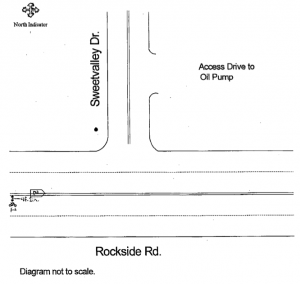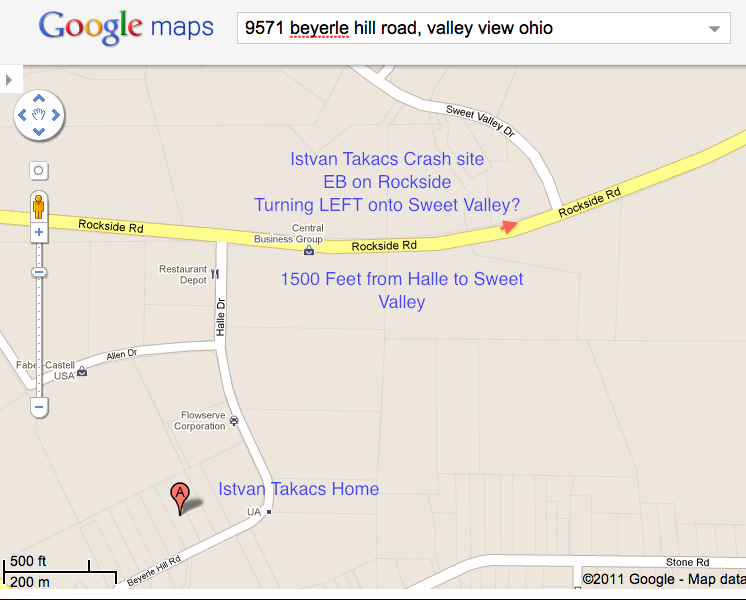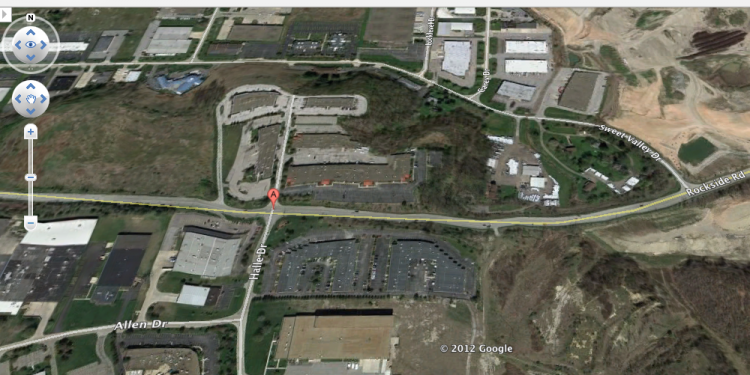Istvan Takacs was 76 years old when he was struck by a Silverado while riding his bicycle on September 29, 2010 on Rockside Road in the little village of Valley View, Ohio. There was very little written in the media about the crash – as I write this I cannot find a single article today.
So what happened? Well, according to what could take the gold medal as the WORST POLICE REPORT EVER FILED IN A DEATH CASE, the crash happened around 4:00 pm on a clear Wednesday afternoon. Little else is known. A man was KILLED and the Valley View Police Department issued a three-page “crash report” which contains NO witness statements, NO photographs, NO measurements, NO toxicology reports and NO real “evidence” about what happened.
Worst Report Ever? You be the Judge!
You can find the whole, complete page-by-page crash report here –> 2010 09 29 Valley View Police Report
So what happened here? According to the report, the cyclist was in the curb lane and moved left into the lane in which Ralph Cross was driving a 2003 Chevy Silverado. The report concludes that the cyclist hit the right quarter panel of the truck despite Mr. Cross’s driving left of center, into on-coming traffic. The speed of the car is noted at “30” which, of course, equals the speed limit. That’s an interesting batch of conclusions – maybe even true – who knows … Where did these conclusions come from? How did those words end up on that page?
We don’t know. I don’t have a clue.
If Mr. Cross was interviewed, that interview was not made part of the record. If he gave a statement, wrote one out, that was not included. When I called and asked if ANY photographs were taken in this crash which led to the death of a 76 year old Hungarian man I was told that no photos were taken. But… at least there was a sketch…er…
Oh yea… the sketch…
wow… it’s hard to believe they took the time to put it on a separate page… thank goodness they told us it was “NOT TO SCALE,” eh?
Nice job on the roads, eh? Can you see the “sketch” of the crash down there in the lower left corner? Let me help you…
Apparently “Ptl. M. Arnold, Badge No. 7322” enlisted his six year old son to draw this sketch for him/her… but I digress…
What do these measurements mean? Is this where the bike ended up? Were there any witnesses? Was Mr. Cross questioned? Was he tested for alcohol or drugs? Was the bike moved following the crash?
In a case where a person is KILLED in a crash the people of the State of Ohio, and Valley View, Ohio deserve better – they deserve to know what happened. The family and friends of Mr. Takacs deserve a thorough, detailed investigation into his death.
What I wanted to do was look at each fatal bicycle crash and try to figure out what happened and why. What lessons are there for future riders, motorists, police officers?
What happened here? Who knows…there are too many unanswered questions…
Was the cyclist simply careless and rode into the car’s path? Was the motorist driving too fast? Was the motorist paying attention? Did the cyclist fail to see the huge Silverado? Where was Mr, Takacs going? What was Mr. Takacs wearing? Suit and tie? Roadie kit? Where is the written, signed statement of the motorist? Were there passengers in the Silverado? Did Mr. Cross have a cell phone? Where is THAT data? Were there other witnesses who saw what happened? Where are THEIR statements?
Where are the photos of the Silverado? What was damaged? Was the mirror knocked off? Those big mirrors are known to whack cyclists… Where are the photos of the bike. What was damaged? Can the bike damage be lined up with the damage to the Silverado?
What about scene photos and measurements? Were there ANY skid marks, gouge marks, debris from the crash. Where is that mapped out? The “debris field” can be very important in trying to figure out where folks came from and where they were going. Usually, accident investigators will carefully mark each bit of evidence, and then measure it and mark the measurements on a special page using reference points that allow anyone who reviews the report to go back to the scene and recreate the investigation. As you can see, no such details are present in the 3-page report.
If you look up Mr. Takacs address and map it out from the collision scene, it looks like this:
Was Mr. Takacs was heading towards Sweet Valley and looking to make a left turn on Sweet Valley? Heading out Rockside? Rockside Road is generally NOT a place for the meek and mild – but many active, regular cyclists are not the meek and mild variety…
The sad thing is all we are left with from the Valley View Police Department is three stinking pages of NOTHING… this has all the earmarks of, at best, an example of extremely careless, negligent poor police work and, at worst, a “wink and a nod” between cop and motorist … I hate to think that way, but serious cases deserve hard serious police work …and this report leaves WAY too much open for debate…
© 2025.




It is disheartening, but I suspect there are far worse examples. In my opinion, police tend to go into these things with a set of preconceptions that tend to make them take the same amount of care as if they were required to write a report on the death of an animal on the road. The preconceptions are:
1. Cyclists don’t really belong on the road.
2. Since cyclists don’t belong, the victim was the prime contributor to his/her death.
3. Because they drive cars, motorists are a lot more like police officers than cyclists, and they are therefore automatically more responsible.
4. Unless the motorist is staggering around, obviously blind drunk, and given facts 1 – 3 above, the police aren’t going to spend any time trying to attach blame to the motorist.
5. The cyclist is dead, and is therefore a handy scapegoat. Blaming a dead victim makes the officer’s job a lot easier.
What I’ve found is that in crash/injury cases the incidence of sloppy investigations occurs… in death cases, though, the investigation is almost always detailed… 30-60 page reports are the norm with dozens to hundreds of photos, detailed statements taken of all possible witnesses, and the motorist, accident reconstruction attempted, carefully drawn field sketches with measurements to all debris found at the scene… This is the worst death crash investigation I’ve ever seen…period… bar none… nothing even comes close…
My very first “big” bike case was a fatal crash in which a 15 year old boy was killed. The police did a detailed investigation, took lots of photos, but simply reached a wrong conclusion… in my opinion, and in the opinion of my expert… and we got the officer to recant on cross examination, and agree that my expert knew more about how to analyze this type of crash than he did – we settled the case after that… The mother of that boy almost didn’t pursue a claim because the police told her it was her son’s fault – Sadly, I doubt that Istvan’s family will pursue a claim either…someone needs to hold these cops up as an example of how NOT to do it….
Well, I guess it’s good to know that the vast majority of such cases are treated seriously by police. What I have heard of such cases led me to believe that shoddy investigations are the norm. It certainly seems to be the case that police are unlikely to charge motorists whose cars are the last thing a cyclist bounces off before dying.
Most cases that I look at are investigated pretty well, actually. 20 years ago this was not the case – 20 years ago we didn’t have all that many “bike cops” either… Cases with little in the way of injury or damage are the most likely to be brushed aside… I still see lousy investigations in some cases with serious injuries- things that leave you scratching your head – but virtually all fatal crashes, except this one, are pretty solidly investigated…
When we ride we must understand we all take risks. Is it no surprise that automobiles will hit you,– they hit each other. I ride with a few of the clusters and I see out and out violations of every traffic rule we are suppose to honor. The most violated, is groups blowing through stop signs. It is of epidemic proportions. I will say this, the Monday night right out of the Hartwell Kroger is by far the best supervised ride I have been on. Jeff’s take no prisoner attitude about safety is commendable. With that group, safety is truly paramount in all they do. What most cyclist do not understand is they, for the most part understand their rights. Sadly the motorists do not! They view cyclists as a nuisance. How do you educate a motorists? I have lived here for over 16 years now and have yet to see one public service announcement addressing cyclists safety. I honestly do not think most cycle groups and cyclists take safety to heart. I work in big steel, I have worked in many dangerous jobs and I fully understand that safety is much more then rhetoric, it is life and death. Most people who ride, have never been in day to day danger and have never seen the results of poor safety, first hand. It is much like most things in their lives, given no regard until they are involved.
Blame the police and the system I have to say poppycock! If you advertise as a community cycling group with the name of the city predominantly in your title then you take civic responsibility for “all that is cycling” in that metropolitan statistical area. If not, use another title such as Gives a Shit Cycle Club. I guess I ramble, that is my way, but in all of this I say lets stop crying and moaning about deaths and do something pro-active. Me, I stay off the roads as much as possible, when I do ride them I pick time, place, who I ride with and location with great care. When I am own the road I understand my cycling rights go as far as the from and rear tires of my bike. I also understand I assume the risk and seriously no doubt in my mind understand that every car is bigger then me and can kill me. As hard as it is to swallow, I understand they are always in the right, because might will always be right when it comes to car on cycle interaction. Understand the threat and understand how to survive. It work for me in war and I sure as hell know it will work for me out on the road.
Thank you for writing… you are right that very little “education” is done – motorists are left with their opinions based on a few ticked off moments watching a cyclist blow a stop sign or whatever, and that’s it – these 2 fatals may not have much to do with fixing that, but they HAVE opened the dialog – one that has been lacking here for a long time… You are right that each cyclist is ultimately responsible for his/her own ride – you can’t expect others to protect you, you have to protect yourself. That’s a major lesson in the motorcycle training classes… “SEE” – Search ahead, Evaluate Risk, Execute a plan to avoid it. 10-12 seconds ahead – Very few folks go out to “learn” how to ride a bike, or ride as an adult in traffic – classes are out there, but it’s one of those things everyone just “knows”… but.. really… they don’t…
I share your disgust with those who abuse our right to ride by refusing to follow basic traffic law – there is no excuse for this. Not only does it put you at risk, but it puts the reputation of cycling at risk.. it puts at risk everything cyclists have fought to achieve for 130+ years in Ohio… the CCC was founded during the first bike boom in the 80’s… the EIGHTEEN eighties… if you go to the NY Times archives and read cycling stories from those days you find that today we are fighting the very same legal, and public opinion, battles – cyclists were/are reckless, they don’t obey the law, they ride too fast for those around them [bike trail complaint] and they spook the horses… well… OK, maybe that last one has cleared up a bit…
J. Rogers might have the kernel of an idea there. What if we created our own ‘responsible biking’ clubs and put our telephone numbers with ‘Tell me how I’m riding’ written on our backs whenever we rode. That way, people could phone us up and we could maybe start a dialogue about cycling laws and the common misunderstandings about cycling practices.
On the other hand, I guess it could end in cyclists being abused over the telephone on a daily basis, adding more stress to the abuse we get on the road.
But maybe it would be worth a try.